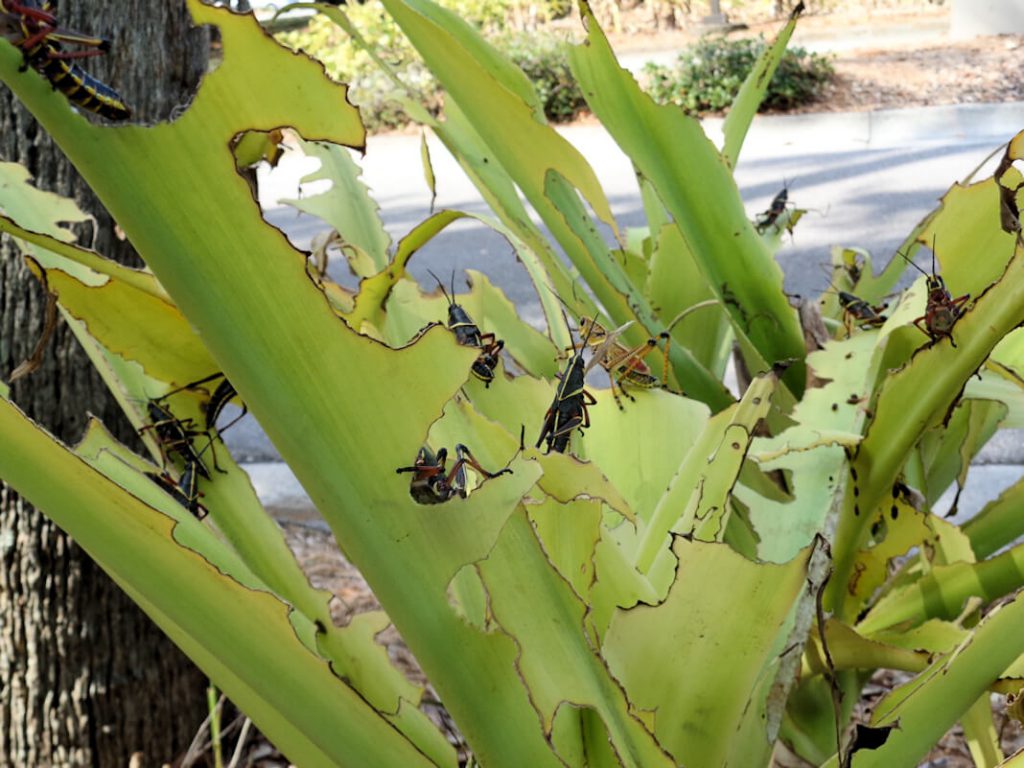
As I drove into the entrance of the Murdock Administration Building, I glanced at the landscape and noticed that something was amiss. The large magnificent crinum lilies normally on display were mere stubs of their former selves. Sitting proudly on the crinum remains and staring back at me with compound eyes were various stages of the Eastern Lubber Grasshopper. While populations of this giant, slow grasshopper vary from place to place in Charlotte County, some initial reports suggest a good year for these insects in 2021.
These Eastern Lubber Grasshoppers emerged earlier from the ground as they hatched out from last year’s eggs. The young grasshoppers are called nymphs. Nymphs are immature grasshoppers that look exactly like small adults except that they lack wings, may be a different color, and cannot reproduce at this stage. The nymphs that we see now are black in color with yellow stripes. To make room for their ever-expanding size, a nymph sheds its skin or molts and gets a little bigger every fifteen to twenty days. At the last molting, they become full-fledged adults. You can’t miss an adult lubber! The adults are huge and yellow in color with black dots and red coloration on the hind wings. Females are bigger than males and can get up to three and one-half inches long. The adults also have a pair of short, useless wings.
In addition to their large size and striking coloration, lubbers also have some other defenses to protect themselves. The lubber grasshopper has toxic properties that keep various animals from eating them. These grasshoppers can produce a frothy spray from their midsection which can irritate potential predators. As such, lubbers are not normally consumed by predators except by a bird called the loggerhead shrike. These birds capture and impale the lubbers on thorns which allows the toxins to degrade in a few days.
While lubbers are large, they tend to eat less than some of their smaller relatives as far as consuming landscape plants. This is of little comfort to those whose landscape is eventually covered with these large insects! Their favorite plants include amaryllis, Amazon lily, crinum, and related plants, as well as oleander, certain jatropha, the Mexican petunia, and the lantana. Some weeds are not sparred and may end-up on the lubber’s menu including chamber bitter and Florida beggarweed. Lubbers have several invertebrate natural enemies including parasitic flies and nematodes which work behind the scenes to take out a few of these grasshoppers. As lubbers are large targets and move slowly, non-chemical control via hand-picking, can help reduce numbers. Keep in mind that the smaller nymph grasshoppers are easier to control than adults. There are some chemical options, including spinosad when used as per label directions, but often an overwhelming infestation cannot be easily stopped. Also, while the largest number of adult lubbers will be observed in July and August, the single generation per year will eventually decline.
Now you know who ate the crinum lilies. Lubber grasshoppers are not everywhere in Charlotte County, but when present can be numerous. Monitor populations now and take any practical actions you can to suppress this potential pest to manageable levels. For more information on all types of Florida insect issues, or to ask a question, please visit https://www.facebook.com/CharlotteMGLifeline/ . Ralph E. Mitchell is the Director/Horticulture Agent for the UF/IFAS Charlotte County Extension Service. He can be reached at 941-764-4344 or ralph.mitchell@charlottecountyfl.gov.
Resource:
Capinera J. L. & Scherer, C. W. (2018) Eastern Lubber Grasshopper, Romalea microptera . The University of Florida Extension Service, IFAS.
 0
0

Comments are closed.